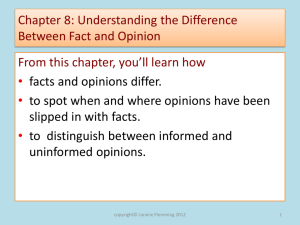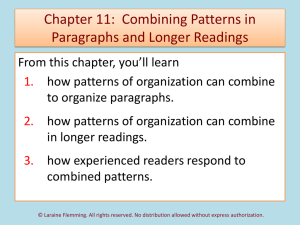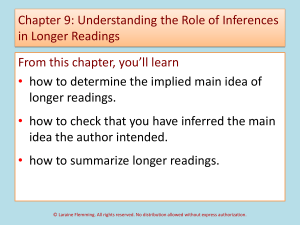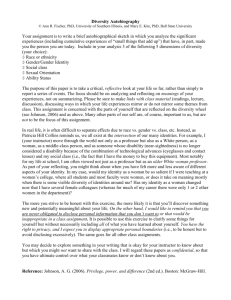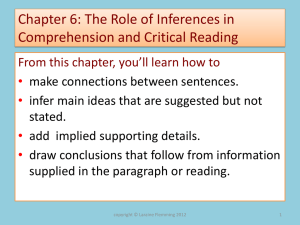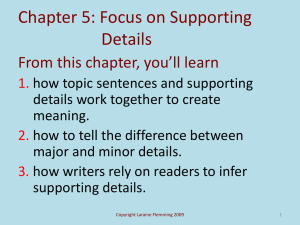Understanding, Outlining and Summarizing Longer Readings
advertisement
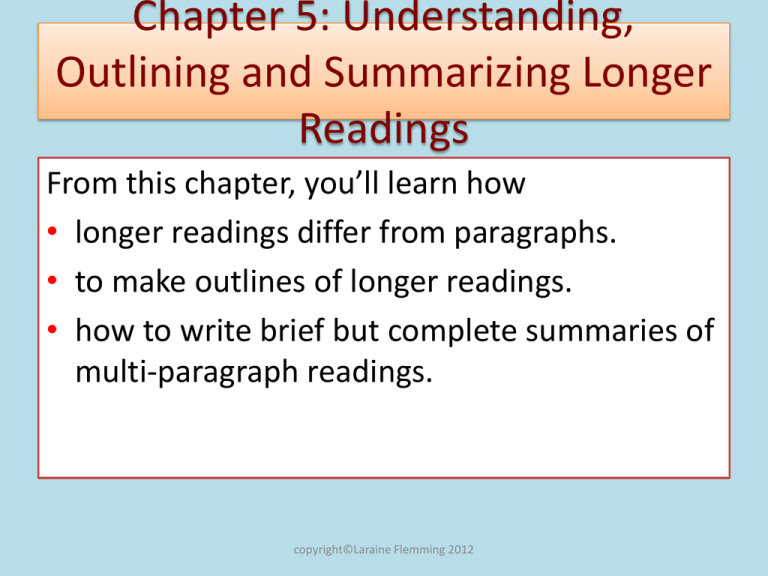
Chapter 5: Understanding, Outlining and Summarizing Longer Readings From this chapter, you’ll learn how • longer readings differ from paragraphs. • to make outlines of longer readings. • how to write brief but complete summaries of multi-paragraph readings. copyright©Laraine Flemming 2012 Paragraphs and Longer Readings: The Similarities Single and multi-paragraph readings both 1. usually focus on one stated main idea. 2. move back and forth between general and specific levels of language and thought. 3. make use of introductions that pave the way for the main idea. 4. sometimes restate the main idea at the end. 5. employ transitional devices that help readers follow the author’s train of thought. 6. occasionally imply rather than state the overall main idea. copyright©Laraine Flemming 2012 What are the Differences? 1. Thesis statements govern longer readings in much the same way topic sentences unify paragraphs, but thesis statements can extend beyond a single sentence. 2. Because a writer can tackle more complex material with more space, major details in longer readings are entire paragraphs rather than single sentences. 3. Sometimes even minor details get a whole paragraph to themselves. 4. Longer readings usually have titles, and the titles frequently introduce the topic under discussion. Sometimes the titles even announce the main idea. copyright©Laraine Flemming 2012 The Key Difference: The Importance of Developing Double Vision • With multi-paragraph readings, you have to keep an eye on how the overall main idea is developed paragraph by paragraph. However, you also have to understand each individual paragraph in its own right. • Put another way, you have to figure out how the overall main idea controls the individual paragraphs and how the individual paragraphs develop the main idea of the entire reading. copyright©Laraine Flemming 2012 What the Reader’s Double Vision Looks Like in a Diagram Thesis Statement Good instructors have three key characteristics. The have a good grasp of their subject matter. They aren’t afraid of questions or disagreements. They have a sense of humor. With longer selections, readers need to (1) consider how the supporting paragraphs answer questions raised by the thesis statement (2) understand the point of each paragraph and (3) understand what each point contributes to the main idea expressed in the thesis statement. copyright©Laraine Flemming 2012 Outlining as a Method of Taking Notes When using an outline to take notes, keep in mind: • For purposes of review, it helps to give your outline a title. • Your outlines don’t have to be formally correct; mix up the symbols any way you want, as long as you understand them. • Indenting is crucial for showing relationships; for instance, items that line up underneath one another are equal in importance. • Abbreviate wherever you can but not so much you don’t know what you meant after a few weeks have passed. • Outlines usually work best with very detailed material that has a clear underlying structure. copyright©Laraine Flemming 2012 Outlining: Example This is a passage that seems right for outlining: • A study conducted between 2002 and 2007 in hospitals in North Carolina found that patients were frequently the victims of medical errors. The most common problems cited were errors in how procedures were performed, inappropriate drug dosage, and the spread of hospitalacquired infections. The lead author of the study Dr. Christian Landrigan also emphasized that he did not believe hospitals in other regions of the country would fare better in such a study. The results of the study appeared in 2010 in The New England Journal of Medicine. copyright©Laraine Flemming 2012 Outline Example North Carolina Study of Hospitals Finds Errors 1. Study conducted between 2002-2007 shows patients victims of medical errors. – poorly performed procedures – wrong drug dosage – hospital acquired infections 2. Lead researcher says other hospitals wouldn’t do better. --published in 2010 New England Journal of Medicine copyright©Laraine Flemming 2012 3 Tips on Using Outlines for Taking Notes 1. Indent to show relationships. Note how even a quick look at the previous outline gives you the two key points of information (1) The study found errors in North Carolina hospitals (2) Hospitals in other regions are unlikely to do better. 2. Paraphrase, don’t copy. Outlining can help you absorb the information but only if you translate the author’s words into your own. Copying doesn’t make your brain do enough work. 3. Be selective about every word. Pick out only the words you absolutely need in order to call up the meaning when it comes time to review. copyright©Laraine Flemming 2012 Learning to Summarize A Word to the Wise Paraphrasing and summarizing go hand in hand. In fact, writing a summary depends heavily on paraphrasing but requires more attention to selection of detail. Both, however, are utterly essential to any form of serious academic work. To remember what you read or store it in any form--in your brain, on your computer or in a page of notes, you need to be able to paraphrase and summarize. As writer Joshua Foer, expressed it in Slate, “Lots of people claim to have a photographic memory, but nobody does. Nobody.” Paraphrasing and summarizing-- not any mythical photographic memory-- are the twin keys to remembering what you read. copyright©Laraine Flemming 2012 Pointers on Writing a Summary 1. A summary should generally reduce a text to about onequarter of its original length. 2. Whether you are summarizing for yourself or for someone else, your goal is to paraphrase the author’s main idea or point. 3. You need include only those details essential to making the main idea clear to the reader. If the writer uses three examples to make the same point, your summary probably needs only one of the examples. 4. Let the main idea be your guide. If the main idea refers to four reasons why social networking is a professional tool, your summary needs to state all four reasons. copyright©Laraine Flemming 2012 Final Wrap: Understanding, Outlining and Summarizing Longer Readings Read the following passage. Then pick the best summary: Nineteenth-century poet Emily Dickinson has been hailed as an innovative artistic genius. But a recent study suggests that the source of Emily Dickinson’s creativity may have been mental illness. Psychiatrist John McDermott argues that she suffered from several psychological disorders. For example, her work exhibits signs of bipolar disorder. Her most creative period spanned the four years between 1862 and 1865, when she wrote more than half of her 1800 poems. During this time, she also experienced manic shifts in mood, swinging from fear to euphoria to deep melancholy. She also might have been afflicted with a seasonal form of depression. Her productivity declined sharply during colder, darker months,. Her references to winter are also accompanied by thoughts of death. She appears, too, to have suffered from agoraphobia, the fear of open, public spaces. When she was still in her twenties, she exhibited reclusive tendencies. Eventually, she never left her house at all. copyright©Laraine Flemming 2012 Choose the Best Summary and Be Prepared to Explain Why It’s the Best. Here are the First Three Choices: 1. The nineteenth century poet Emily Dickinson was considered by many to be a genius, but psychiatrist John McDermott argues that her art was fueled by mental illness. As proof of his claim, he cites her most creative years, 1862-1865 as the time when she also suffered from manic depression. He also mentions her fear of open, public spaces, which eventually kept her house bound but may also have kept her writing poems. 2. For the psychiatrist John McDermott, Emily Dickinson’s art was less a reflection of her genius and more a result of her disturbed state of mind. 3. Emily Dickinson’s art was the product of a disturbed mind. Always fearful of open spaces, by the end of her life, she never left home. copyright©Laraine Flemming 2012 4. Emily Dickinson has often been called a genius, but psychiatrist John McDermott suggests the origin of her genius may well have been a collection of psychiatric disorders. Between 1862 and 1865, Dickinson was at her most creative. During this period, she wrote more than half of her 1800 poems. But at the same time, she was also experiencing severe mood swings. McDermott also notes that she was most productive during months where there was more sun. This suggests that she may have suffered from seasonal depression. Dickinson also suffered from fear of open and public places, and by the end of life, she never left her house at all. copyright©Laraine Flemming 2012 A Word to the Wise Charles Bazerman, a writer, researcher and teacher I particularly admire, suggests in his book The Informed Writer that readers prepare for writing a summary by going through a passage and crossing out every piece of information they think is non-essential. If you are summarizing for an assignment, I highly recommend this strategy. copyright©Laraine Flemming 2012 Final Wrap: Understanding, Outlining and Summarizing Longer Readings 1. True or False. A thesis statement is a single sentence that sums up the main idea of a multi-paragraph reading. 2. True or False. Titles of longer readings are meant to catch the reader’s attention, but they don’t provide much real information. 3. True or False. In a longer, multi-paragraph reading, one major detail could take up an entire paragraph. copyright©Laraine Flemming 2012 Final Wrap: Understanding, Outlining and Summarizing Longer Readings 4. Indenting in an outline is important because ________________. 5. Read each sentence in the following paragraph. The sentences are numbered so you can write down the numbers on a piece of paper. After each number, put an S to indicate that the information needs to go in the summary or an N to indicate it is not necessary. copyright©Laraine Flemming 2012 Final Wrap: Understanding, Outlining, and Summarizing Longer Readings • 1The geography of the area around New Orleans, the failure of the levees, and the elimination of wetlands all contributed to the devastating destruction caused by Hurricane Katrina in 2005. 2Built in a natural bowl that is in some places five feet below sea level, New Orleans is actually lower than the three major bodies of water—the Mississippi River, Lake Pontchartrain, and the Gulf of Mexico—near it. 3Man-made levees had been built to protect the city from these waters if they overflowed; however, constructing these levees also destroyed natural marshes that had once acted as a buffer, absorbing much of the energy of hurricanes roaring in from the Gulf. 4Consequently, when Hurricane Katrina hit the coast near New Orleans on August 29, 2005, there was nothing to slow the enormous waves generated by the storm’s 125-mile-per-hour winds. 5A storm surge in Lake Pontchartrain slammed into one levee and broke it, allowing water to pour into the city. 6For weeks afterward, floodwater soaked New Orleans, ruining what the hurricane’s high winds hadn’t already demolished. 7In the end, over 1,300 people were killed, hundreds of thousands lost their homes, and $75 billion in property was destroyed. (Source of information: Katherine Mieszkowski, “Why New Orleans Is Sunk,” Salon, September 3, 2005, ) copyright©Laraine Flemming 2012
